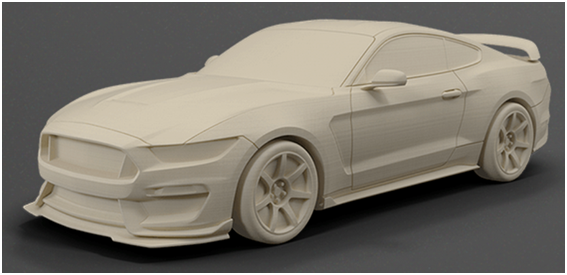![[Source: 3DCars.com ]](https://fabbaloo.com/wp-content/uploads/2020/05/Automakers_img_5eb094dc39636.png)
Cameron Torti and Charles Goulding of R&D Tax Savers examine 3D printing in today’s automotive industry.
The recent discussions concerning the potential merger of Fiat, Renault and Nissan have put the automotive industry at the forefront of the news. The industry has boomed since bottoming out in 2009, achieving sizable growth year-to-year. However, just recently unit sales have dropped significantly for the first time during the economic expansion. Technological integration with cars has also been implemented at a relatively steady rate with incremental advancements in each subsequent model. Now, both of these trends are set to change drastically in the near future.
A Shift from Ownership to Access
Traditionally, cars have been viewed as must-have possessions for anyone who could afford them, whereas today, consumers are starting to see them more as a service like Netflix, Spotify, and other subscription services. Consequently, a new market for sharing vehicles has emerged. Turo, founded in 2010, gives car owners the opportunity to earn money from their vehicle when it is not in use. Why not let a neighbor supplement your lease payment when you’re on vacation or just drove home from work? This shift in consumer behavior may reduce demand for cars, an issue compounded by the massive growth of well-established ride-sharing services such as Uber and Lyft. Changing business models and adapting to the way consumers choose to get around is something that car manufacturers and dealerships will need to adjust to if they are to stay in business.
Environmental Considerations Continue to Impact the Industry
![[Source: The Fuse ]](https://fabbaloo.com/wp-content/uploads/2020/05/Automakers2_img_5eb094dc9a5d4.png)
Sales of electric and hybrid cars are accounting for a growing percentage of total vehicle purchases as increasingly more hybrid and electric vehicles are being offered by manufacturers. A rise in public awareness and concern regarding carbon emissions is the main driver. Several countries across Europe, as well as the U.S. and China, are pressuring automakers to reduce emissions. Tighter emissions regulations mean automakers must invest billions of dollars into electric technology.
Fiat Chrysler may still merge with French manufacturer Renault, which has a major investment in Japanese manufacturer Nissan Motor Company. The merger would give the three manufacturers the resources needed to compete with larger firms that often share their vehicle parts and tech to stay ahead. Headlining the news for several weeks, we’ve decided to examine the 3D printing capabilities of these companies.
3D Printing: A Saving Grace for Cost Reduction
Behind every new technology is a prototype. Rapid prototyping remains perhaps 3D printing’s strongest application. Automakers faced with growing technological challenges will benefit greatly from the use of 3D printing, enabling them to keep their R&D costs down and bring new features to market faster.
Fiat Chrysler
Fiat Chrysler has been working with additive manufacturing processes for years now but working with 3D printing to produce end-use parts is a work in progress. Aside from prototyping and some OEM parts, 3D printing has improved testing capabilities. Fiat designers are using 3D printed see-through plastic components, allowing engineers to view how fluid flows inside the axle system. Improved axle fluid dynamics translates to more fuel energy transferred to the road.
Renault
A project manager at Renault Trucks said that metal additive manufacturing was successfully used to reduce the weight of engines by 25%. Engines made via this process were tested for 600 hours and performed optimally, demonstrating that 3D printing can offer reliable alternatives even in metal.
Nissan
![Nismo's 3D printed gurney flap [Source: 3D Systems ]](https://fabbaloo.com/wp-content/uploads/2020/05/Automakers3_img_5eb094dcee3bc.png)
Nissan is another company uses 3D printing to create prototypes and experiment new designs. Last year, they switched from CAD software to Materialise software, accomplishing their printing goals in half the time. 3D printing has also proven to be invaluable for Nissan Motorsports (NISMO). One challenge that the NISMO team has faced is improving the aerodynamics of Nissan Altima racecars. Not generating enough downward force, the old wing was hindering speed and cornering. Nissan engineers then 3D printed a smaller wing-like structure known as a gurney flap. Design lead Joe Carmody describes it as “a complex piece of geometry, with compound curves that would be difficult to manufacture using traditional molds.” Such precise manufacture ring strategies will likely find their way into consumer models.
The U.S. Federal Research & Development Tax Credit
Enacted in 1981, the now permanent Federal Research and Development (R&D) Tax Credit allows a credit that typically ranges from 4%-7% of eligible spending for new and improved products and processes. Qualified research must meet the following four criteria:
-
Must be technological in nature
-
Must be a component of the taxpayer’s business
-
Must represent R&D in the experimental sense and generally includes all such costs related to the development or improvement of a product or process
-
Must eliminate uncertainty through a process of experimentation that considers one or more alternatives
Eligible costs include U.S. employee wages, cost of supplies consumed in the R&D process, cost of pre-production testing, U.S. contract research expenses, and certain costs associated with developing a patent.
On December 18, 2015, President Obama signed the PATH Act, making the R&D Tax Credit permanent. Since 2016, the R&D credit has been used to offset Alternative Minimum Tax (AMT) for companies with revenue below $50MM and, startup businesses can obtain up to $250,000 per year in payroll tax cash rebates.
Conclusion
The automotive industry is currently experiencing a rapid shift in consumer behavior and the rate of technological development which poses many opportunities and challenges for manufacturers. Keeping up with R&D costs and anticipating consumer behavior are the two principal challenges. One key tool at their disposal is 3D printing which can offset costs associated with adapting to the changing automotive landscape.











Charles Goulding and Preeti Sulibhavi consider how two prominent automotive firms, Ferrari and Ford, are using 3D printing.